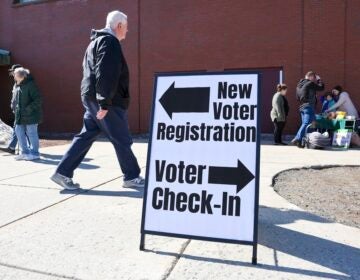Both parties have important lessons to learn from Election Day
Democrats can no longer treat demographics as destiny, while the GOP would be wise not to disenfranchise their own potential voters, writes Murali Balaji, Ph.D.

File photo: Election workers, left, check in voters before they cast their ballots in the Pennsylvania primary in Philadelphia, Tuesday, June 2, 2020. (AP Photo/Matt Rourke)
Since Election Night, political scientists, pollsters, political pundits and many others have tried to make sense of the results. On one hand, President-elect Joe Biden had a clear and convincing victory, both in the popular vote and the Electoral College. In addition to Democrats rebuilding the “Blue Wall” that includes Pennsylvania, Biden won Arizona and is leading in Georgia, two states that had long eluded Democratic hopes.
On the other hand, Democrats down ballot suffered, with the party unable to flip the Senate, hold onto hard-fought House districts won just two years ago, and losing over 80 state legislative seats across the country. Republicans also won a higher share of voters of color, particularly Black and Latino people, putting a dent in the belief that the GOP’s outreach to communities of color has suffered under President Donald Trump.
In Pennsylvania, the outcomes seemed mixed, with Trump capturing a larger vote share of people of color while suburban voters split their tickets, helping the GOP hold onto legislative seats and also helping them win the state auditor and treasurer races.
The numbers will continue to be crunched, but two key takeaways have emerged: the Democratic Party can no longer treat demographics as destiny while the Republicans would be wise to stop trying to disenfranchise their own potential voters.
On the first point, many Democratic leaders have continued to buy into the theory that the Party is the future home of a permanent governing majority, thanks to rapid demographic changes. In 2002, Ruy Teixeira and John Judis’ book, The Emerging Democratic Majority, argued that the party would be well positioned to take advantage of a rising share of the Black, Latino, and Asian voting public.
That hasn’t necessarily happened, in part because communities of color tend to skew more socially conservative on many issues. Republicans have used issues like abortion, support for small business, legal immigration, and criminal justice as ways of making inroads among voters of color. Additionally, in 2020, Republicans also grew their support among some Latino and Asian voters by positioning themselves as anti-socialist, a term that has proven continually effective at drawing Cuban, Venezuelan, Vietnamese and increasing numbers of Indian voters.
Additionally, identity politics are a double-edge sword. While Trump played upon white grievances, some Democrats responded by calls for allyship, which at times could be seen as condescending to communities of color. Take, for example, this tweet exchange between progressive House member Ruben Gallego of Arizona and a progressive activist. Gallego and other Latino elected officials and leaders have highlighted how progressive activists have tried to label communities without their buy-in. In fact, Pew reported in August that just 3% of Latinos use the term Latinx.
But identity politics wasn’t the only issue. Economic divides have played a significant role in the GOP’s inroads among low-income and less educated voters of color, particularly as wealthier and more educated white voters in the suburbs shift towards Democrats. It’s a fascinating trend that may determine how effective both parties will be in building and maintaining governing coalitions for years to come.
In that vein, what Republicans have tried to do in terms of suppressing voters of color through onerous registration efforts or ballot access, racial gerrymandering, or in the case of Florida, simply denying recently enfranchised voters a chance to register, is a textbook example of cutting off one’s nose to spite their face. For years, Republicans gave up on the idea of trying to win a larger vote share among people of color. With the surprising results now in clearer focus, it might behoove Republican leaders to reconsider their animosity towards getting people of color to the ballot box.
What does this all mean? Besides awaiting how redistricting impacts future elections, it could mean that both parties may need to stop paying attention to their consultants and pollsters and do the work of reaching out to all voters. That could be one positive outcome for both parties in the wake of the end of the Trump era.
Murali Balaji, Ph.D., is a journalist, author and academic with nearly 20 years of experience in diversity leadership. He currently serves in diversity leadership and as a lecturer at the Annenberg School for Communication at the University of Pennsylvania. He is the founder of Maruthi Education Consulting, consulting several congressional campaigns on cultural competency.

Get daily updates from WHYY News!
WHYY is your source for fact-based, in-depth journalism and information. As a nonprofit organization, we rely on financial support from readers like you. Please give today.





